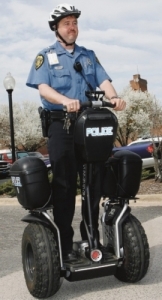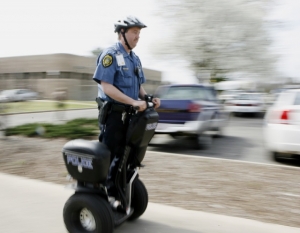More officers getting trained to ride Segway
By Nick Hiltunen
Published in News on March 13, 2009 1:46 PM

News-Argus/GREG SOUSA
Goldsboro police officer Steven Powers rides a Segway Personal Transporter on Thursday afternoon. The vehicles are used by some city police officers to not only allow more contact with citizens, but to make some patrols more efficient, officials say.

News-Argus/GREG SOUSA
Goldsboro police officer Steven Powers rides a Segway Personal Transporter on Thursday afternoon. The vehicles are used by some city police officers to not only allow more contact with citizens, but to make some patrols more efficient, officials say.
Steven Powers isn't the only Goldsboro police officer riding a Segway anymore.
The department still has only one of the two-wheeled vehicles, but police officials say they might seek another in the future because they believe the unit has good applications for their work.
They have also made Powers, a warrant officer, the Segway coordinator, which means he monitors its use, battery charges and any damages that might occur.
He also has trained about 35 officers to ride the Segway, which Powers said can be used for chasing down shoplifters and delivering forgotten paperwork.
And there are others uses as well, Powers said.
Critics of police "cruisers," have long maintained that the police car separates the person with the badge from the people he is trying to protect.
Powers said the Segway, which draws a lot of attention -- as evidenced by the slowing traffic as he rode the unit near the police station -- is a good solution to that problem.
"Everyone sees it, and they want to talk to you, and they want to see what it is," Powers said.
And they often ask if they can ride it, even though the answer to that question is always "no."
"Our policy doesn't allow our citizens to ride it," Powers said, adding that he is often reassured by people who promise "not to steal it."
Still, that personal interaction is just one reason he enjoys using the vehicle.
"I personally enjoy it. It beats walking," Powers said, adding that reaction to the vehicle is mixed. Older officers tend to shy away from it, he said.
"You have some who enjoy it that would rather ride this than walk, and then you have some older ones that don't want to be caught dead on it," he said.
Powers said he is not sure why older people shy away from the vehicle.
Maybe it's partly because the unit is usually used to run the downtown "beat," a walking operation usually given to younger officers.
"The officers that are checked off on the Segway, when they do their downtown work, they can ride the Segway downtown," Powers said.
When it comes time for special events, though, Powers said Maj. Mike Hopper usually asks him to ride the vehicle -- primarily to help ensure that children aren't run over by the unit.
At top speed, the Segway can run up to 12 mph. It can also last about 12 miles on a single charge of its lithium-ion battery, Powers said.
Steering is done by leaning, but the body doesn't actually lean. The Segway's "Lean-Steer Frame Handlebar" does that job for the rider, keeping a person basically upright.
As Powers rode the vehicle, he remained almost perfectly upright, and was able to make 180-degree turns seemingly without effort.
"The only time you really lean your body, is if you're going to do a (sharp) turn, and you have to compensate," Powers said.
The vehicle, which uses computers and motors to keep that balance, is key-driven, and useless without a key -- it will turn into a "brick," and even "growl," beep and rumble if an unauthorized user tries to take it, he said.
"It'll run up to 12 mph. That doesn't seem fast, but when you first get on and learn it, 12 mph is pretty quick," Powers said.
